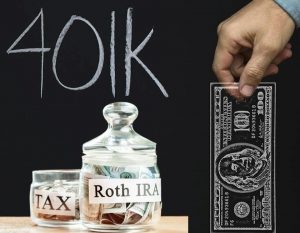June 2022 – Backdoor Roth Conversions

BACKDOOR ROTH CONVERSIONS
What are they?

As we are always looking for more ways to save towards retirement, we wanted to share some information regarding one retirement account funding method: “Backdoor Roth” Conversions (BRCs).
This tool can assist in providing additional tax-free income during retirement and bypass the IRS’ income limitation on Roth IRA contributions.
How do they work?
To discuss the tax benefits of BRCs, we must first define them. Simply stated, a BRC occurs when a taxpayer contributes money to a traditional IRA, and then transfers (or “rolls”) the contributed balance into a Roth IRA account. This strategy allows you to save up to $6,000 ($7,000 if age 50 or over) annually per person (including spouses), over what you are already contributing to your 401(k) in order to diversify retirement income to include taxable and tax-free distributions.
What are the benefits?
For taxpayers with higher incomes, BRCs make it possible to bypass the income limitations of funding a Roth IRA. Under IRS guidelines, most taxpayers with an adjusted gross income under $204,000 (MFJ filing status), or $129,000 (S or HOH filing statuses) are eligible to fund a Roth IRA for the full allowable annual contribution amount. If adjusted gross income rises any higher, contributions into a Roth IRA account are only allowed at reduced amounts and are eventually phased out as ineligible to fund a Roth IRA. However, a BRC allows higher-income taxpayers to bypass these income limitations using a two-step process:
-
A contribution is made to a traditional IRA account. Tax basis is generated in the traditional IRA if a contribution did not generate a tax deduction for the individual due to high income levels.
-
The individual can then convert the funds contributed into the traditional IRA account into a Roth IRA account generally tax-free*.
Since the money transferred from the traditional IRA is after-tax money and the taxpayer did not receive a tax deduction for their contribution, the BRC transaction may be tax-free*.
*Please note, this is the case as long as there has been no growth on the funds contributed into the traditional IRA account. If there is growth, these earnings will be taxed. Generally, the contribution and conversion will be made concurrently and there will not be any earnings incurred in the traditional IRA account. Please also note that if the contribution is tax-deductible and the taxpayer did receive the tax benefit for their traditional IRA contribution, the taxpayer will be taxed on the funds converted to the Roth IRA.
*Please keep in mind that the BRC is only successfully tax-free if the taxpayer does not have any funds in another IRA account. If the taxpayer has funds in other IRA accounts, the pro-rata rule applies. The pro-rata rule says that the IRS will view all of the taxpayer’s IRA accounts as one single, aggregate account (separate from the spouse) for the purposes of calculating the taxable portion of BRC funds. The pro-rata rule includes pre-tax and after-tax funds. When the taxpayer wishes to convert a portion of this aggregate amount to a Roth IRA using a BRC, the taxpayer is not permitted to choose whether to convert pre-tax or after-tax funds to the Roth IRA. As such, the aggregate amount in pre-tax and after-tax funds is factored into the taxability calculation for BRCs, and a portion of the BRC will be taxable.
In using BRCs as a tax planning tool, it is also important to consider anticipated tax brackets – do you anticipate your tax bracket will be lower in the future, or higher? If your tax bracket will be higher in the future (or if tax rates are set to increase) and your income is too high to fund a Roth IRA directly, it might be beneficial to consider funding a Roth IRA through a BRC every year to benefit from the tax-free distributions from the Roth IRA later when their tax bracket is higher.
Benefits of Roth IRA Accounts
-
Taxpayers can skip required minimum distributions (RMDs): while traditional IRAs force taxpayers to take RMDs, Roth IRAs do not have this requirement. Taxpayers can withdraw only what they need and allow the remainder to grow tax-free in the Roth IRA.
-
Estate Planning: Roth IRAs can be passed down to beneficiaries tax-free as long as the account has been open for at least 5 years. The beneficiaries will need to take RMDs from the inherited Roth IRAs, but they will not be taxed on the distributions.
Keep In Mind:
-
Roth IRA conversions are permanent, meaning a taxpayer will not be able to convert the funds back to a traditional IRA.
-
Converted funds are tax-free as long as the taxpayer waits 5 years before taking distributions that were part of the BRC, and the taxpayer is 59 ½ years of age or older.
-
If distributions are taken out of a Roth IRA before the taxpayer is 59 ½, there is a 10% tax on the distribution. There are a few exceptions to this 10% tax, including the following:
-
The taxpayer has passed away
-
The taxpayer is taking a disability distribution
-
The taxpayer is taking the first-time homebuyer’s distribution
-
Please feel free to reach out to us with any questions if you are considering a Backdoor Roth IRA Conversion. We will be happy to assist you in determining if this IRA account funding option is a good fit for you.
JUNE 15, 2022 – 2nd quarter estimated payments for 2022 are due to the IRS and Colorado Department of Revenue
SEPTEMBER 15, 2022 – 3rd quarter estimated payments for 2022 are due to the IRS and Colorado Department of Revenue
EMPLOYEE SPOTLIGHT: CALEB THETFORD

Caleb joined Soukup, Bush & Associates as an intern for 2018, 2019, and 2020 tax seasons before starting full-time as an associate in August 2021. He works in both the tax and audit departments of the firm.
Caleb graduated summa cum laude from Colorado State University in May 2020 with his Bachelor of Science degree in Business Administration with concentrations in accounting and finance as well as a minor in Spanish. During his undergraduate degree, Caleb served as the president of CSU’s chapter of Beta Alpha Psi for over two years and was named the spring 2020 Department of Accounting’s Outstanding Graduating Senior. In May of 2021, he completed his Master of Accountancy with a specialization in taxation. He is a member of the American Institute of CPAs and the Colorado Society of CPAs.
In his free time, Caleb enjoys sports (especially baseball) as well as video games, board games, music, and time spent with family and friends.
